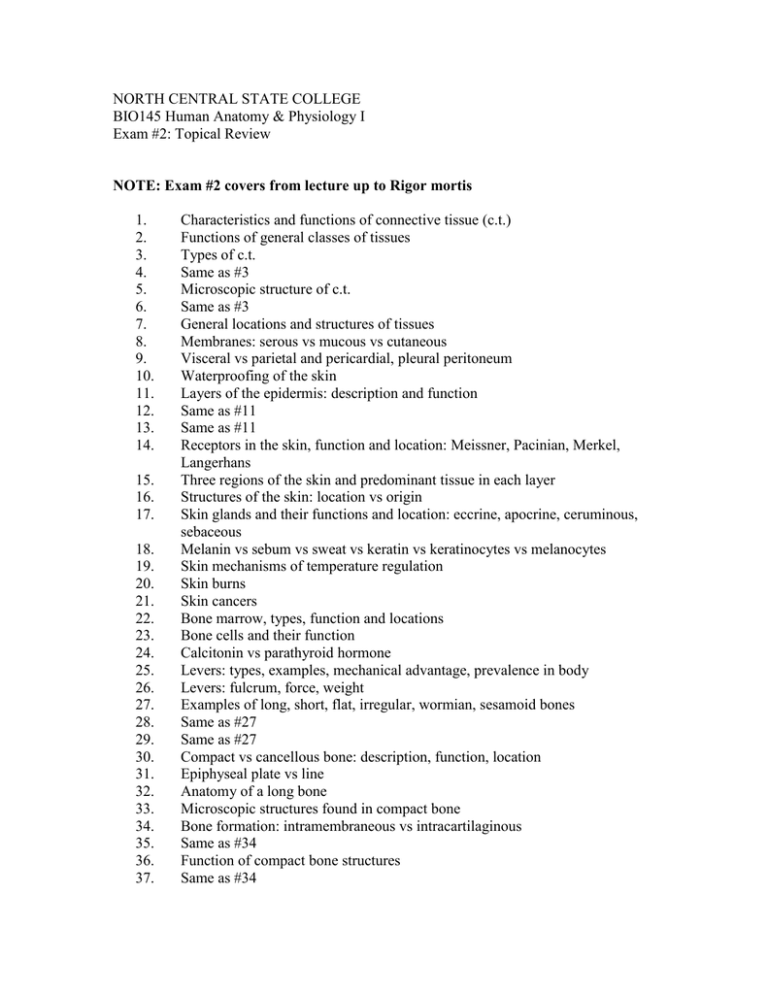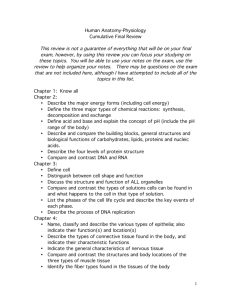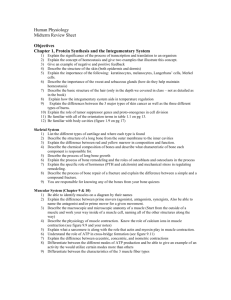Exam #2 - North Central State College
advertisement

NORTH CENTRAL STATE COLLEGE BIO145 Human Anatomy & Physiology I Exam #2: Topical Review NOTE: Exam #2 covers from lecture up to Rigor mortis 1. 2. 3. 4. 5. 6. 7. 8. 9. 10. 11. 12. 13. 14. 15. 16. 17. 18. 19. 20. 21. 22. 23. 24. 25. 26. 27. 28. 29. 30. 31. 32. 33. 34. 35. 36. 37. Characteristics and functions of connective tissue (c.t.) Functions of general classes of tissues Types of c.t. Same as #3 Microscopic structure of c.t. Same as #3 General locations and structures of tissues Membranes: serous vs mucous vs cutaneous Visceral vs parietal and pericardial, pleural peritoneum Waterproofing of the skin Layers of the epidermis: description and function Same as #11 Same as #11 Receptors in the skin, function and location: Meissner, Pacinian, Merkel, Langerhans Three regions of the skin and predominant tissue in each layer Structures of the skin: location vs origin Skin glands and their functions and location: eccrine, apocrine, ceruminous, sebaceous Melanin vs sebum vs sweat vs keratin vs keratinocytes vs melanocytes Skin mechanisms of temperature regulation Skin burns Skin cancers Bone marrow, types, function and locations Bone cells and their function Calcitonin vs parathyroid hormone Levers: types, examples, mechanical advantage, prevalence in body Levers: fulcrum, force, weight Examples of long, short, flat, irregular, wormian, sesamoid bones Same as #27 Same as #27 Compact vs cancellous bone: description, function, location Epiphyseal plate vs line Anatomy of a long bone Microscopic structures found in compact bone Bone formation: intramembraneous vs intracartilaginous Same as #34 Function of compact bone structures Same as #34 38. 39. 40. 41. 42. 43. 44. 45. 46. 47. 48. 49. 50. 51. 52. 53. 54. 55. 56. 57. 58. 59. 60. 61. 62. 63. 64. 65. 66. 67. 68. 69. 70. Skeletal system: appendicular vs axial Bone disorders Steps in fracture healing and simple vs compound fractures and traumatic vs spontaneous Examples of joints: synarthroses vs amphiarthroses vs diarthroses Diarthroses: anatomy and associated structures Types of joints and examples: ball and socket, hinge, pivot, condyloid, gliding, saddle Types of joints Types of joints Diseases of joints Joint motions Special characteristics of muscular tissue: terms and definitions Terms: description and relative sizes- muscle, fascicule, muscle fiber, myofibril, myofilament, actin/myosin Same as #48 Parts of a muscle fiber and sarcomere, description and function: sarcolemma, sarcoplasm, T tubules, sarcoplasmic reticulum, Z lines, actin, myosin, “heads”, I band, A band, H zone Same as #51 Same as #51 Steps in a muscle fiber contraction: which happens first Same as #54 Same as #54 Same as #51 Muscle contraction and role of:, calcium ions, ATP Same as #54 Same as #54 Events at motor end plate Parts of muscle responsible for microscopic appearance General feature of skeletal muscle General function of muscle Same as #64 Rigor mortis cause Energy sources of muscle what is used up first, second, third Which energy source does a sprinter use Which muscle fibers are found in the legs of marathon runners Which fiber type depends on oxygen and is most fatigue resistance, which is least dependent on oxygen and most prone to fatigue








